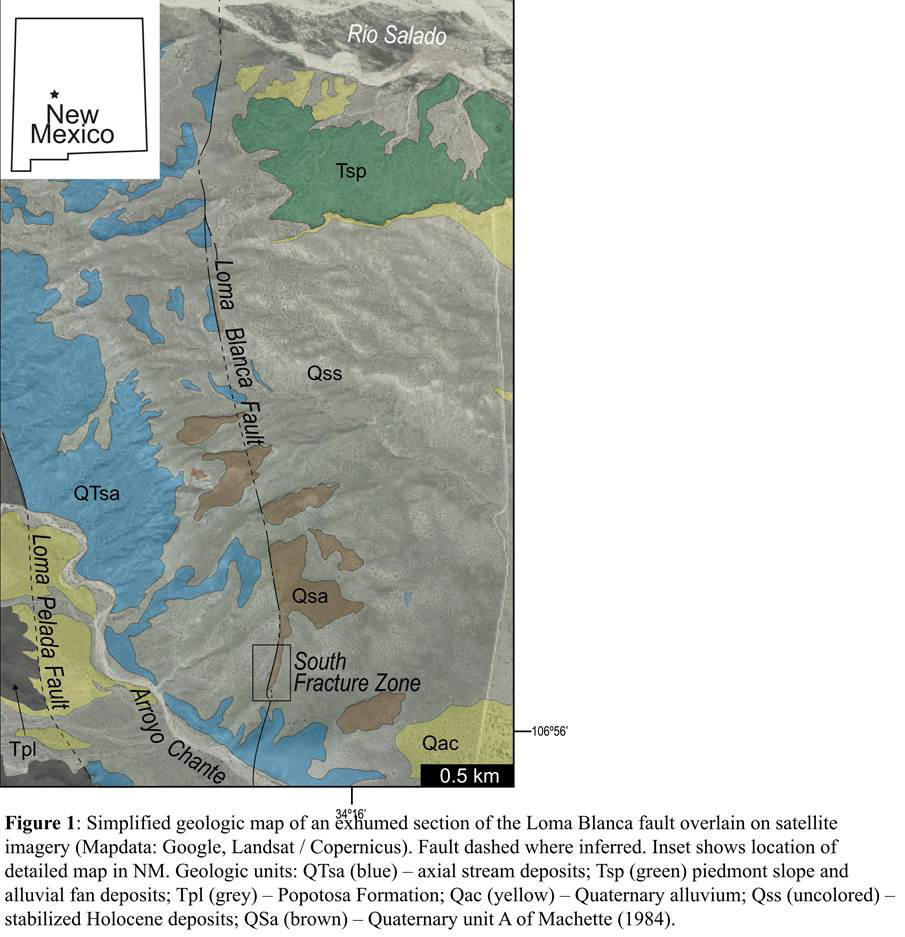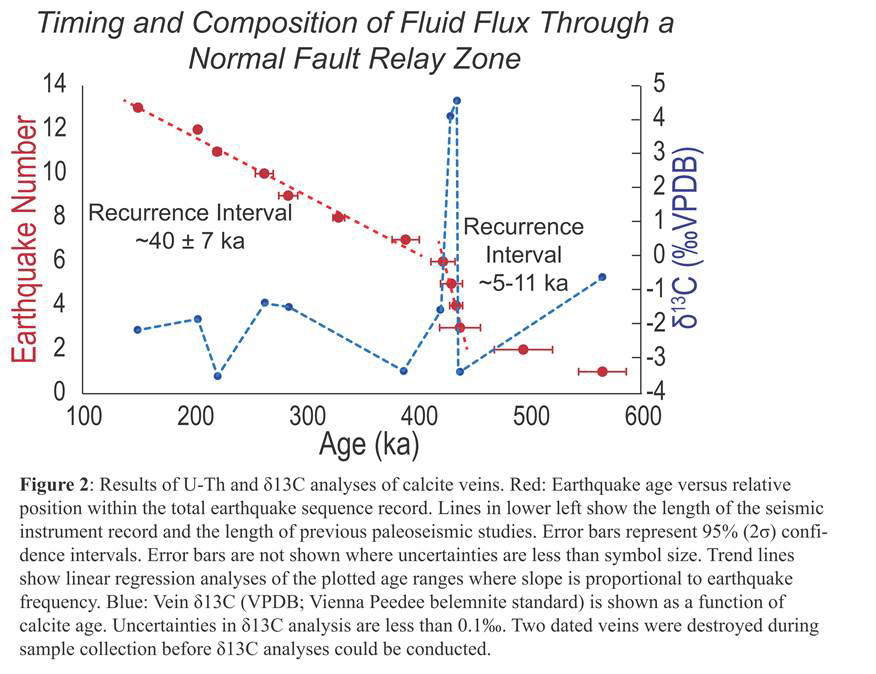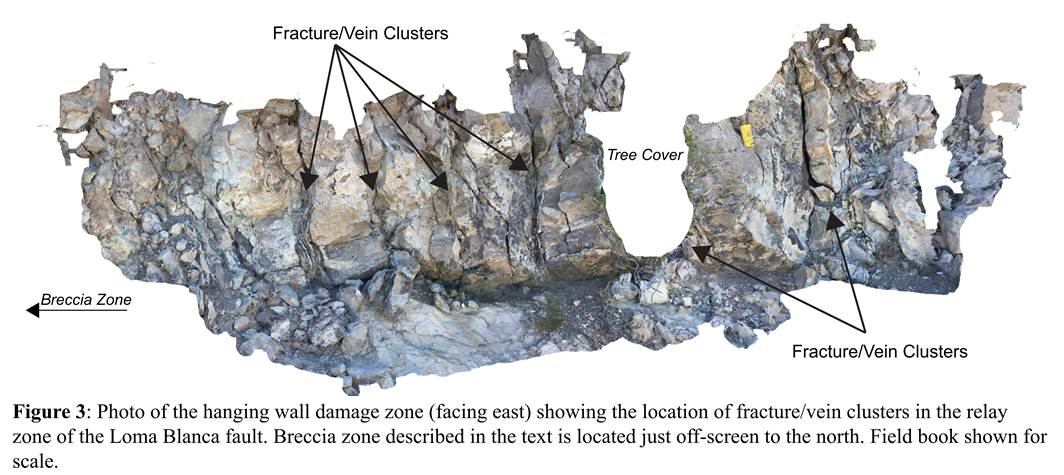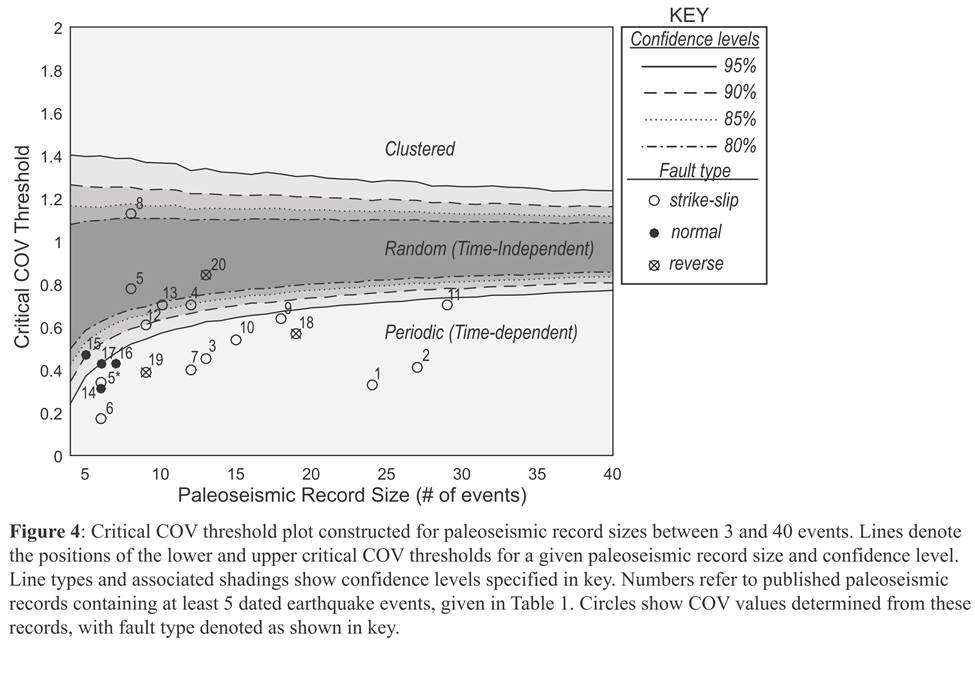Reports: ND855807-ND8: Rates of Calcite Cementation, Style of Deformation, and Timing of Flow through the Loma Blanca Fault Zone, Socorro Basin, NM
Laurel B. Goodwin, PhD, University of Wisconsin, Madison
Fault-zone cements preserve a fossil record of fluid sources and pathways. Our research addresses the fact that this record has been incompletely explored, particularly for the most common fault-zone cement: calcite. Exceptional exposures of calcite-cemented structures in the Loma Blanca normal fault of the Soccoro Basin, Rio Grande rift, NM (Fig. 1), have dictated the direction and progress of our work. We set out to use a variety of geochemical tools to track preferential flow pathways through extensional basins in both space and time, and find increasingly that the Loma Blanca’s integrated record of fluid-fault interactions, including fault mechanics, adds depth and breadth to our understanding of the generation and evolution of such pathways. Significant results are detailed in the following sections.
The Evolution of a ‘Sealing Fault’ that Periodically Leaks
Within the study area, the Loma Blanca fault juxtaposes variably lithified sands that range from lower Pliocene to Quaternary in age (Fig. 1). In the hanging wall of the fault, these sands preserve a fossil record of localized fluid flux: pore-filling calcite cement. Cemented hanging wall sands also record pre-cementation shearing in the form of a foliation and lineation defined by grain-shape preferred orientation. These cemented sands, now low-porosity sandstone, provide an effective fault seal that is resistant to weathering and extends up to 10 m from the fault core. Erosion has excavated the margins of hanging wall sandstone, providing exposures of its internal structure.
In Williams et al. (2016), we showed that post-cementation fault slip produced opening-mode fractures in hanging wall sandstone. These fractures – and subsequent fluid flux – were preferentially localized in a relay zone, where fault segments overlap, which is consistent with formation during seismic fault slip. Subsequently precipitated calcite vein cements provide a record of paleo-fluid flux through the fractures. Microstructures in the resulting veins document repeated episodes of fracturing and sealing by calcite, indicating that relay-zone permeability was episodically enhanced. To explore the evolution of fracture formation and sources of fluids that precipitated vein calcite through time, Williams et al. (2017) integrated stable isotope analyses, U-Th dating of vein cements (Fig. 2), and statistical analysis to evaluate the hypothesis that the veins record fault-valve behavior. The data show that the periodic failure (recurrence interval ~40 ka) exhibited by most of the documented earthquakes records a stress renewal process, with fractures leaking deep basinal brines following failure rather than failure being driven by changing pore fluid pressure. However, a subset of veins formed ca. 430 ka records an influx of fluid from a source likely associated with a magma body ca. 19 km below the fault exposure. These veins are also associated with a dramatic increase in earthquake frequency (recurrence interval ~5-11 ka), consistent with elevated fluid pressure.
The abundance of calcite veins in the relay zone indicates that these sections of the fault served as pronounced fluid flow conduits prior to sealing. This year, we conducted detailed mapping to better understand the spatial evolution of these flow pathways. Veins recording earthquakes driven by a stress renewal process exhibit an unusual distribution, consisting of regularly spaced clusters recording multiple earthquakes per cluster (Fig. 3). Veins recording elevated pore fluid pressure, are, in contrast, associated with breccia at the northern margin of the relay zone. Both recurrence intervals fall within the range exhibited by well studied normal faults in the Basin and Range province and Rio Grande rift.
To explore the broader implications of our data, we further developed the statistical analysis reported in Williams et al. (2017) to evaluate fundamental patterns exhibited by earthquakes in a range of tectonic settings. Key contributions of this work, reported by Williams and Goodwin (in prep), are (1) the majority of faults that have been studied in detail exhibit periodic earthquakes and (2) a robust analysis requires a minimum of 5 dates on earthquakes (Fig. 4). Collectively, our data provide unique insight into the time scales of fault slip, syntectonic fluid migration, and sealing events associated with normal faults and the processes that govern them.
Ongoing Research
We recently measured strontium and lead isotopes in previously dated calcite veins for which we had previously obtained oxygen and carbon isotopic data. The goal of this work is to expand the toolkit of geochemical tracers used to read the fluid record of diagenetic cements by comparing (previously unstudied) Pb isotopic data to (well established) stable and Sr isotopic data. Preliminary comparisons indicate that Pb data can vary between samples that show stable isotope values that are identical within measurement uncertainties, a promising indication of tracer potential.
Our final U-Th dating effort will be focused on understanding the temporal evolution of vein clusters. Geochronologic work to date shows that adjacent veins do not record sequential earthquakes. Fracture sealing times estimated from three of the largest calcite veins in mapped clusters indicate that fractures close in ~20 ka, defining the approximate duration of post-slip fluid migration. Additional work will help us understand vein cluster development in both space and time. In other localities, such data could be linked with basin and hydrocarbon generation histories, with the goal of informing resource assessment in extensional systems.
Impact of the Work
This ACS PRF ND grant has supported our effort to provide the first quantitative constraints on 3D flow paths in space and time through integrated geochemical and geochronologic analyses of fault-zone calcite cements. This funding has allowed us to establish several key new collaborations as well as support an exceptional PhD student – Randolph Williams – through his transition to a post-doctoral fellow. Over the past year, Williams continued to work at the unusual interface between geochemistry, geochronology, and structural geology, which has significantly enhanced his contributions to fault and petroleum geology as well as broadened his potential career options. We note papers either published or in review in the above narrative. A final paper will integrate field structural analysis with additional U-Th dating to document the space-time evolution of vein clusters in a normal fault relay zone.















